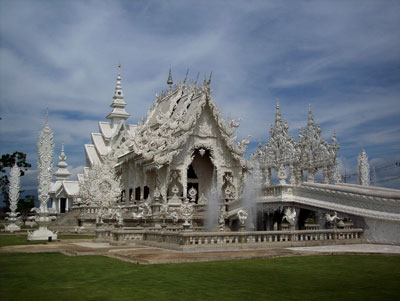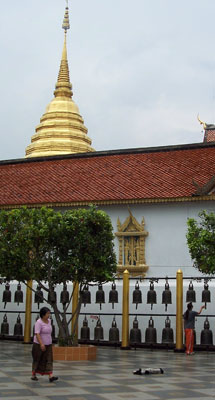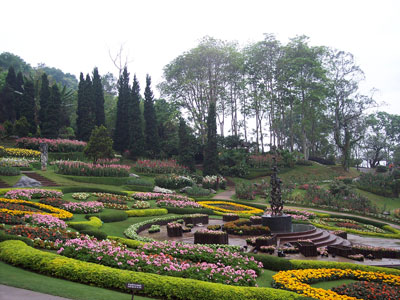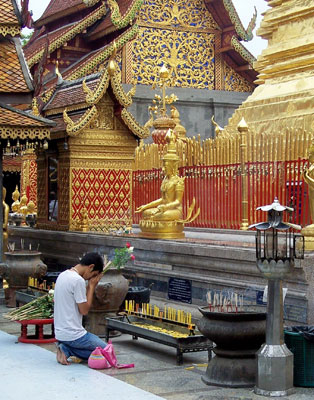Chiang Mai and Chiang Rai
by Randy Keck, part 3 of 3 on Thailand
An evening flight from Bangkok to Chiang Mai signaled the beginning of the northern Thailand portion of my March ’08 Thailand adventure. The lush, mountainous north was to provide a welcome respite from the heat I had experienced in central Thailand.
Chiang Mai temple tour
The following morning, with my new guide, Adul, I began a fascinating tour of local wats (temples) that helped unveil a history of the north of Thailand that is intricately interwoven with that of its regional neighbors Laos and Myanmar (Burma).
We visited, in order, Wat Chedi Lang, Wat Chiang Man (the oldest temple in Chiang Mai), Wat Phra Singh, Wat Suan Dok and, finally, the inspiring Wat Doi Suthep, at an elevation of 3,400 feet and overlooking Chiang Mai city.
After listening to visitors ring bells on the plaza at Doi Suthep, I was inspired to procure my own, one of bronze and deep-toned. Mysteriously, when I employ its tonal magic at my home office desk in the morning to ring for coffee, nothing happens.
Adul advised that many of the young monks we saw wearing bright orange robes in and around the temple complexes were only undergoing monk training for short periods before returning to school and normal life. He explained that men of all ages, married or not, can undertake monk training, even for as little as a 2-week period.
The monk training helps aspirants shed ego and gain humility and mental and spiritual focus in an environment that is removed from the distractions of the world. Such life training is universally encouraged by the family. For some, the monk training carries on to a permanent calling.
Chiang Mai central
My hotel in Chiang Mai was the Chiang Mai Plaza, perfectly situated in a central, walk-to-everything location, including to the extensive night market.
Only 50 meters from the front of the hotel, I discovered my obligatory Internet café plus, in a wonderful garden setting, the Whole Earth Restaurant, featuring an extensive menu of Thai and Indian cuisine. My deliciously prepared shrimp and vegetable tempura at $5 was a terrific value.
Following lunch, I enjoyed a swim at the Plaza pool before getting back to serious business, the night market. After what seemed an eternity (two hours) of dutifully filling orders received by e-mail from my wife, Gail, back home, I had accumulated enough spices to start a Thai restaurant. Lemongrass and saffron proved to be the supreme values.
Opportunities for Thai massage — inexpensive by any measure — abounded in Chiang Mai, particularly in the central area around my hotel and at the night market. I picked at random a place at the night market and, luckily, had the best one-hour Thai massage of my trip at an unbelievable rate of 140 baht; try $3.70. Needless to say, a generous tip was warranted.
Real Thai massage is a combination of standard massage, stretching, chiropractic and reflexology. I require a deep treatment beyond the standard (don’t-hurt-the-tourist) type and had to request such. In particular, the deep stretching seems to cure just about all that ails and is both relaxing and energizing.
On to Chiang Rai
Fortunately, I was well rested for a long day of touring, which would culminate in Chiang Rai in the early evening. A morning stop at a Karen village (the hill tribe’s origins are in Burma) revealed some of the ongoing Thai government efforts to redirect the villagers from former opium growing to other crops, crafts and tourism.
Next were brief stops at a hot springs and a roadside coffeehouse to sample and then purchase some local Doi Chaang coffee (smooth espresso, hard beans).
Adul and I then climbed to Doi Tung, a mountain retreat of temples, a museum and gardens that honor the revered, now-deceased Princess Mother (the current king’s mother) and her lifelong humanitarian and cultural efforts on behalf of the Thai people.
The magnificent hillside gardens exploded in a labyrinth of colors accented by fountains in a nirvana setting. I definitely needed more time at Doi Tung and, regretfully, had to pass on visiting a hilltop temple with great views at the complex.
Golden Triangle
In mid-afternoon we finally arrived at the famous Golden Triangle, where Myanmar, Laos and Thailand meet at the junction of the Mekong River and small Ruak tributary.
We boarded a longtail speedboat for a closer look at the area, viewing up close a resort casino in Myanmar and locals panning for gold along the Laos shoreline.
We also, sadly, observed on the Laos shorefront 50- to 60-year-old teak trees, which are now becoming rare, being loaded onto a boat for transport downstream to waiting markets in China. At least massive teak reforestation is underway in Thailand, with the realization that the trees must mature for nearly half a century before prime-time reharvesting is possible.
Before departing the Golden Triangle, across from the boat landing I visited an opium museum which detailed the utterly fascinating history of opium production in the 3-country region.
Before returning to Chiang Rai, we briefly toured the riverside city of Chiang Saen and the historic ruins of the ancient Wat Chedi Luang, dating to 1291.
On my final morning in Thailand I arranged an unscheduled tour of Chiang Rai City, including walking to impressive Wat Phra Keow and through the bustling city markets, where I replenished my supply of wasabi peas.
Later, on the outskirts of Chiang Rai, we explored a rather new temple complex, Wat Rong Khun, where all current and future buildings will be white and adorned with small, mosaic-tile-like sections of inlaid glass. The philosophy behind this translates roughly to “Buddha sees everywhere,” which was a more-than-fitting note upon which to conclude my exploration of amazing Thailand.
Thai travel planning
My host in Thailand, Value World Tours (an ITN advertiser), advises that most people who undertake their Thailand cruise/tour program deviate somewhat from the brochure itinerary in terms of pre- and post-tour extensions. I certainly would recommend an additional day or more at the end in the Chiang Rai region.
For example, my guide specifically recommended including nearby scenic Doi Mae Salong Mountain, topped by the settlement of Santi Khiri, home to descendants of Chinese Nationalist soldiers who settled the area in the 1940s. The mountain today hosts a plethora of coffee plantations and fruit orchards. In the area and also highly recommended is an Akha hill tribe at Loryo village.
Some Thailand visitors may wish to extend to the beach areas of southern Thailand, such as Krabi or the resort islands of Phuket or Ko Samui. These areas will be the focus of my next visit.
For information on their cruise/tour programs worldwide, contact Value World Tours (Fountain Valley, CA; 800/795-1633, e-mail cruise@valuecruises.net or visit www.valuecruises.net).
For information, brochures and maps on all areas of Thailand, I suggest contacting the cohost of my visit, the Tourism Authority of Thailand (Los Angeles, CA; 323/461-9814, mail tatla@ix.netcom.com or visit www.tourismthailand.org/la).




